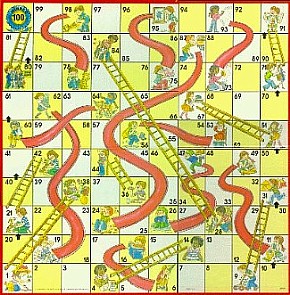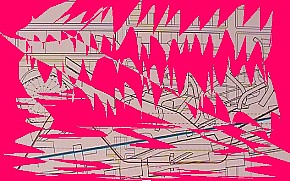2009.02.17 07:58
Bilocation Syndrome
The delegation from India brought along a paradigm of Sanchi.
Augustus saw it and said "I'm to be buried like that."
And he was.
Then full house, hence Hadrian's bust out.
The huntress Diana came from MADxMAD garden to preside over the virtual pool of Nympheum Neronis. "New York is a nice place to visit, but I wouldn't want to live there."
knock knock
who's there?
instead of a telegram, read a novel
but I was expecting Dora Nobb!
Here a Versailles, there a Versailles, everywhere a Versailles, sigh.
You mean like the distance and angle from Hall of Mirrors to Trianon equals the distance and angle from Capitol to White House?
Not exactly. The latter is somewhat magnified.
2003.09.04
a purposeful walk
during the thick of reenactment season
through a space-time continuum
a week later
"I notice within one of the side chapels is the chair used by Pope John Paul II while he was in Philadelphia 1979. Since no one else was around and the railing to the chapel was only 2 feet tall, I decided to go sit in the chair myself. I found those few seconds sitting to be quite intense, so I got up quickly because otherwise I would have gotten way too comfortable."
2009.02.21 18:20
Bilocation Syndrome
Yes, museum as eternal wrest
Otherwise, think of it as

meets

meets

| |
2009.02.21 13:47
Bilocation Syndrome
In 315 AD, the Arch of Trajan was dismantled, moved, redesigned, and rebuilt as the Arch of Constantine
Eutropia: "Just take down the Arch of Trajan, and place it within the new arch."
Helena: "That's perfect, but where do we put the new arch?"
Eutropia: "I say over by the basilica begun by my son."
Helena: "Yes, over by the basilica completed by my son."
Eutropia: "Yes, over by the basilica begun by my son and completed by my son-in-law."
Helena: "Ha! Must you always have the last word?"
Eutropia: "Yes, I confess."
et clement Trajano in Paradiso via Dante
206d
2009.02.24 11:49
pragmatists turning political?
What you describe above relates more to schizophrenic situations, i.e., states characterized by the coexistence of contradictory or incompatible elements, rather than to bilocational situations.
Coexistence and bilocation are not the same thing.
Schizophrenia is a whole split.
Bilocation is two of the same whole.
2009.02.24 20:38
pragmatists turning political?
before things get too carried away here...
bilocation
bilocation
"bilocation as it is, however, accepts the disordered, or varied, virtual. its a baroque and complex intertwining of narratives, myths, of the foundation of logic even prior to logic itself..."
Gosh, that sounds just like Quondam.
2009.02.25 10:52
Bilocation Syndrome
Did Kahn 'research' St. Catherine de Ricci while designing the Dominican Motherhouse of the Sisters of St. Catherine de Ricci? Who knows? There is a sense of bilocation in the design of the Fisher House, and even earlier in the Fruchter House and the executed Jewish Community Center Day Camp. It's probably just a strange twist of fate that these senses of bilocation came to a maturity within the design of the Dominican Motherhouse of the Sisters of St. Catherine de Ricci.
--[what are]The Odds of Ottopia[?]
2009.02.25 13:12
Re: Recent book
Dictionary of Literary Themes and Motifs (1988)
It describes/explains about 200 themes and gives examples of where they appear throughout literature. E.g., Incubus and Succubus, Jealousy, Labyrinth, Lameness, Language, Laughter... So far I read 'Labyrinth' and it's neat how it is both informative and inspiring and gives you leads into other territories to explore.
| |
2009.03.08
journal
Started the process of coordinating the Philadelphia model with IQ. Right now the priority is to bring each section up to the level of completeness a la the data existing thus far. This seems to be the right way to go for Quondam because all the various model data of the entire collection will have a three dimensional place. No doubt this will all be a lot of (drone) work, and I hope it will be worth it, as in something worthwhile architecturally will be gained.
But what is this all really about? It does have to do with "using" the museum, and also using history, specifically architectural history.
Other things going on are:
1. reading A Skeleton Key to Finnegans Wake and seeing how it actually does relate to the ICM, (at least to my interpretation of the ICM). I may ultimately have to read all of Bloomer's Architecture and the Text to make sure I just didn't get her point back them just because I just didn't know any better (about Finnegans Wake).
The other interest in Finnegans Wake is because of the labyrinthine "design" and how I now want to understand and manipulate Quondam as a labyrinthine design. My feeling is that Quondam already is a labyrinth and now I just want to understand and design it better.
2. I want to also employ Quondam as an outlet for architectural fiction, and, right now, the theme of Quondam's architecture fiction is Quondam itself and the buildings in its collection are the novel characters. For what it's worth, I just thought of the Houses for Otto as "ancient" ruins where there are foundational remains but nothing else--we don't even really know if they are/were even houses. (And now I'm seeing how this is very much how Piranesi operated within the ICM and the earlier plans.) In any case, the narrative at Quondam derives from the stories that each building or buildings present.
2009.03.16 11:28
Venturi's Lieb (No. 9) House to be moved (or demolished)
Historical analysis within a space-time continuum is more ongoing productivity and less end-product.
"architectures in the space-time continuum"
architectural history in the space-time continuum
Pergamon, wo bist du?
I'm beginning to wonder which is more immovable, a building or an opinion.
"[This museum should be regarded as a kind of reliquary containing various mementoes symbolizing not only the eternal brother-conflict, but also the military and diplomatic encounters, exchanges and betrayals of recorded history.] An old woman conducts a party through the museum, pointing out relics from the battle career of her hero Wellington, the Iron Duke. There are exhibits under glass and pictures on the walls. A flag, a bullet, a military hat; Duke Wellington on his big white horse; three soldiers crouching in a ditch; a pair of Naopeon's jinnies, making believe to read a book of strategy; and a sex-caliber telescope through which the Duke trains on the flanks of the jinnies."
JC&HMR
2009.03.22
bilocation, etc.
I occurred to me last night that active participation within an online forum is like a degree short of actual bilocation. It's the speed of light involved that brings the degree of separation down to the minimum. I wonder if bilocation will be recognized as a part of network culture.
Read about half of Heidegger's "The Thing" last night. A few pages in, Heidegger's writing started to remind me of Gertrude Stein's writing.
Found out on 2009.03.20 that the base of the Eiffel Tower is just slightly larger than the base of Hadrian's Tomb. Thus directly over Hadrian's tomb is the Eiffel Tower's position within Ichnographia Quondam.
| |
2009.06.06 20:18
how about thom mayne?
Quondam is my site. It's the first virtual museum of architecture, online since 21 November 1996. Earlier this year thingsmagazine.net described Quondam as "Stephen Lauf's epically impenetrable 'online collage', a real labyrinth of a website," and that suits me just fine.
Yes, Quondam is dense, and even I don't know where everything is, so I utilize site-specific google searches to find things.
The numbering system has no meaningful significance beyond its sequentiality; file names, that's all.

The specific image you ask about also has no intended significance in terms of how Thom Mayne may see things, but, as you've now demonstrated, it is capable of inspiring a significance. And that's more or less the point...
2009.06.12 08:36
please comment or destroy, thank you
"In German, a mnemonic can be fashioned from the literal meaning of the Latin word complicare. which means "to fold together (zusammenfalten)": the complicated, then, can be rendered graspable via unfolding (Entfaltung), because it thereby becomes simple (einfach) in a sense of naïve or ingenuous (einfältig). But the Latin word complexus means "mutual embrace," or, so to speak, the labyrinthine [emphasis added], the convoluted: here, simplicity already contains within itself the seed of all the complexity that comes to appearance through its own development. In cases of doubt, then, the complicated can be profitably reduced and simplified--but the complex, in contrast, cannot be simplified with impunity. To say that something is complicated means that the finite number of its determinations cannot be grasped directly. To say that something is complex means, by contrast, that the number of its determinations is simply infinite."
Clemens Bellut, "Ach, Luise, lass ... das ist ein zu weites Feld," or: The Gordian Knot of Complexity" in Complexity: Design Strategy and World View (2008).
Eternal Wrest ... really only the beginning?
"All the world's a next stage."
2009.07.07 12:44
Bilocation Syndrome
finally, after over 85 pages...
At the same time, in parallel...
"As if the Straits of Gilbraltar acted as some metaphysical junction point between the worlds. In those days to pass through that narrow aperture into the vast, uncertain field of Ocean was to behind the known world, and perhaps its conventions about being in only one place at a time. . . .Once passed through, did the ship take two tacks at once? Did the wind blow in two ways? Or was it the giant fish that possessed the power of bilocation? Two fishes, two Jonahs, two Agadirs?
"This smoke in here I've been breathing," said Kit, "this wouldn't be . . . um, hasheesh?"
As if she had exited her life briefly and been given the ability to travel on a parallel course, "close" enough to watch herself doing it, Dally discovered an alternate way to travel by land, port to port, faster than the ship was moving. . . . She sped, it seemed slightly above ground level, through the fragrant late-summer twilight, parallel to the course of the ship. . . . She would return to her deck chair out of breath, sweating, exhilirated [sic] for no reason, as if she had just escaped some organized threat to her saftey.
It's worth noting that the bilocations began just when Kit reached the ultimate depth of his exploration/discovery of the Stupendica as actually two ships. Indeed, he becomes trapped within the parallel time of the Emperor Maximilian, and hence nowhere to be found on the Stupendica. Note too how it's after searching all over for Kit that Dally actually bilocates herself.
| |
2009.07.07
bilocation, finally
Some more on "Bilocation Syndrome":
1. Axis of Life / Bejamin Franklin Parkway.
2. my walk down the Parkway / Axis of Life.
3. the key to Ichnographia Quondam.
4. Pagan - Christian - Triumphal Way of the Ichnographia Campus Martius.
5. Temple of Janus; Arch of Trajan/Constantine.
6. Diana the Huntress/Nympaeum; Vatican/Life of Constantine tapestries; Gates of Hell; Logan Circle/Hadrian's Tomb; Intercourse building/Love.
7. Quondam / Museumpeace.
2009.07.14 20:38
inspiring Maya Linked Hybrid edge
...the Athenian master craftsman and inventor, Daedalus, was given a commission by King Minos of Crete to build a labyrinth, a prison for the man-bull monster, the Minotaur. Later, Minos imprisoned Daedalus and his son, Icarus, in the labyrinth. The two escaped on wings made by Daedalus of wax and feathers, but Icarus flies too close to the sun, his wings melt, and he falls into the sea.
remembering "journey motifs"
2009.09.01 17:53
fashion tip (of the iceberg)
arbitration and arbitrariness blurred
reality being relative to the vastness of its container
arbitration and arbitrariness come into focus as instinct
realms juxtaposed
"the time it takes to do this" as continuum
i.e., "...to compose this novel in a real/virtual manner. Do you assume this intention needs support from the living?"
background music: ...sounds a blur (in a good way) between Saussure and the debunked Blavatsky, but to no surprise as I have heard the two in the same breathe before.
2009.09.03 13:11
fashion tip (of the iceberg)
It was the "post-mortem discourse" that rekindled the vertigo of the mélange. The thought was post-modernism as still life.
But the strange fascination of still life, isn't it also a fiction? Or indeed an ethereal necrophilia?
--The Man without Qualities
The only gesture possible would seem to be stillness, what "in painting is called Stilleben (still life), or in other languages... natura morta (dead nature)."
--ibid
Life is magically arrested in its impermanence: "objects, animals, plants, landscapes and human bodies frozen into stillness by the magic of art," in a sort of "demonical" mystery.
--ibid
The world itseld seems to be suspended in an unending instant, in a landscape like the "sixth day of Creation, when God and the world were still alone, without men"
--ibid
"It is extraordinarily simple, but also very odd," says Ulrich.
"We have found many contrived answers," says Ulrich, "but we have overlooked th simplest: that both may have the intention and the capacity to take everything of which they have experience only as Gleichnis" And "every Gleichnis is ambivalent for the intellect, but for the feeling it is univocal;" and therefore it should be possible to experience "as oneness that which be common estimate is twofold."
"In that instant there occurred to Ulrich the idea of a state of life in which the being here was Gleichnis of the being there, and the impossible experience of being a person with two distinct bodies might lose the thorn of its impossibility."
Gleichnis is never Gleichheit.
--overall Franco Rella
He found Renfrew in a hectic mood, as close to desperation as Lew could recall.
... Lew had the sudden certitude that right now in Göttingen some bilocational Lew was asking Werfner the same question...]
--mirror::rorrim
"magnigicent chaos of the museum"
|